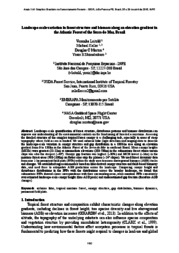Landscape-scale variation in forest structure and biomass along an elevation gradient in the Atlantic Forest of the Serra do Mar, Brazil.
Landscape-scale variation in forest structure and biomass along an elevation gradient in the Atlantic Forest of the Serra do Mar, Brazil.
Author(s): LEITOLD, V.; KELLER, M.; MORTON, D. C.; SHIMABUKURO, Y. E.
Summary: Landscape-scale quantification of forest structure, disturbance patterns and biomass distribution can improve our understanding of the environmental controls on the functioning of forested ecosystems. Assessing the detailed structure of the complex tropical forest canopy is a challenging task, especially in areas of steep topography where field access is limited. We used airborne lidar (light detection and ranging) data to describe the landscape-scale variation in canopy structure and gap distribution in a 1000-ha area along an elevation gradient from 0 to 1200m in the Atlantic Forest of the Serra do Mar in southeast Brazil. Mean canopy heights (MCHs) were greatest (21-22m) at intermediate elevations (200-700m) in the submontane forest where terrain slope was also the steepest (~40º). Canopy gap fraction was highest (~30%) and MCH lowest (~16m) in the montane forest areas (900-1100m) on flatter sites atop the plateau (~24º slopes). We used forest inventory data from nine 1-ha permanent field plots (PFPs) within the study area to assess aboveground biomass (AGB) stocks and changes. We established regression models based on lidar-derived canopy structure and field-based biometry data, and used these to extrapolate AGB predictions across the landscape. Comparing canopy height and disturbance distributions in the PFPs with the distributions across the broader landscape, we found that submontane PFPs showed closer correspondence with their surrounding areas, while montane PFPs consistently overestimated landscape-scale canopy height (thus AGB pools) and underestimated gap fraction (therefore AGB changes).
Publication year: 2015
Types of publication: Paper in annals and proceedings
Unit: Embrapa Territorial
Observation
Some of Embrapa's publications are published as ePub files. To read them, use or download one of the following free software options to your computer or mobile device. Android: Google Play Books; IOS: iBooks; Windows and Linux: Calibre.
Access other publications
Access the Agricultural Research Database (BDPA) to consult Embrapa's full library collection and records.
Visit Embrapa Bookstore to purchase books and other publications sold by Embrapa.

